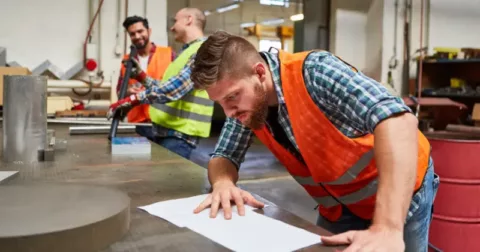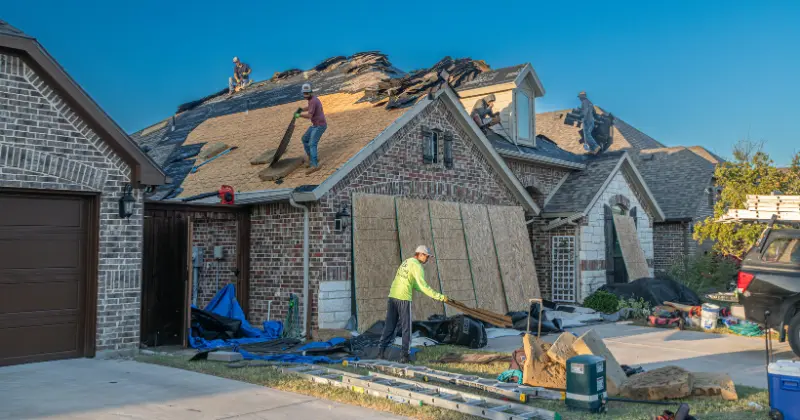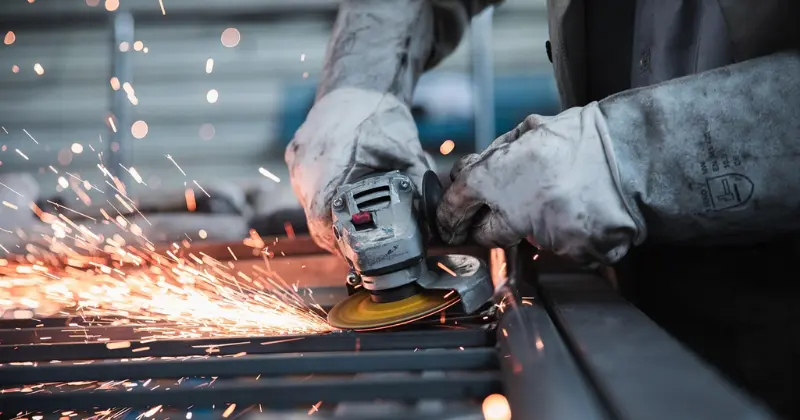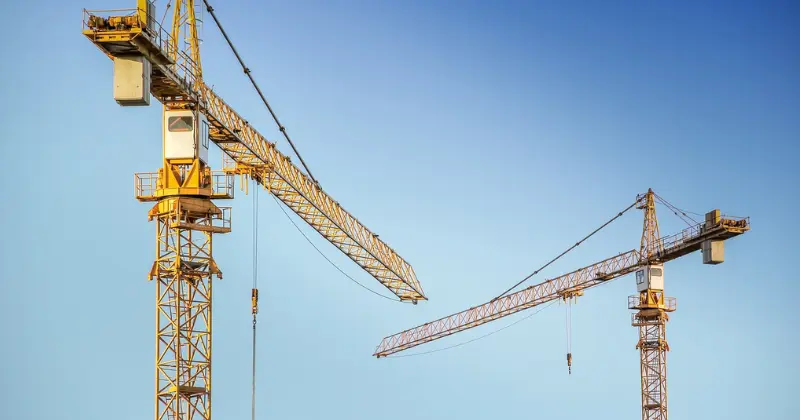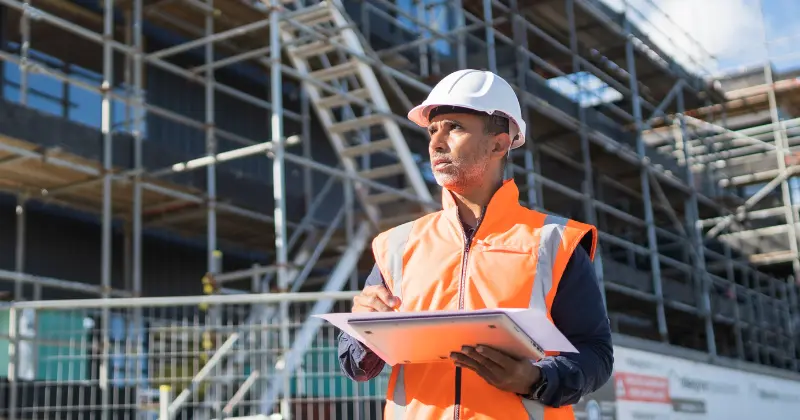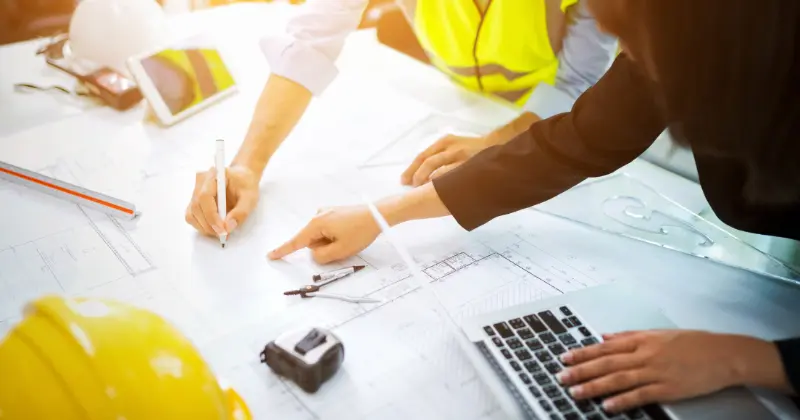11 mins read
Why Construction Collaboration Is Key

- The Issue of Collaboration in Construction Projects
- Importance & Benefits of Collaboration in Construction
- Challenges of Construction Collaboration
- How Technology Improves Construction Collaboration
- Construction Collaboration Technologies
- Tips to Improve Construction Collaboration
- Start Improving Your Construction Team Collaboration
Collaboration is all about working well together. While building trust and improving collaboration may sound clichéd, they remain the most critical way to enhance any construction project.
Quite simply, strong collaboration leads to increased productivity in construction, decreased risk, and greater profits. It’s something every construction team should strive for.
To help boost collaboration in your construction business, we’ve put together this insightful guide describing the importance of cooperation and providing practical ways in which you can improve it. Let’s get started!
The Issue of Collaboration in Construction Projects
It is easy to see the value of collaboration in construction and many other complex industries. Siloed teams often fail to share information that might be significant for other groups, and new innovations that could benefit entire companies or projects can go unnoticed when teams fail to collaborate, wasting valuable opportunities.
While this issue is nothing new in the construction industry, it has gained importance in recent years as schedules are compressed and the tolerance for errors and delays decreases. Communication issues currently cost the industry an estimated USD $31 billion annually due to delays, rework, and lost productivity.
Despite the pressure to share information more efficiently, only 11% of construction field personnel report being able to reliably access the data they need to build. Although the tools and practices needed to improve construction collaboration are readily available, not all project teams are taking full advantage of them. In some cases, software that supports real-time communication is underutilized based on decades of ingrained preference for manual methods and in-person discussions.
Along with the schedule and cost pressures driven by a competitive industry and client expectations, emerging trends like sustainable construction also call for a higher level of collaboration to optimize design, material selection, and installation methods. This cross-functional cooperation, involving sustainability experts, designers, contractors, and other stakeholders, must begin at the earliest stages and continue throughout the lifespan of a project.
Another topic that challenges collaboration in construction is the increasing age gap between seasoned professionals and the tech-savvy younger generation. This interesting and pressing topic was recently discussed in an episode of Hart Hats & Hi Tech, RIB’s construction technology podcast. Check out the episode below!
Importance & Benefits of Collaboration in Construction
Any construction project, no matter how big or small, includes many different teams and decision-makers. All roles and responsibilities are involved in the process, from architects and estimators to contractors and finance managers. The project will suffer if these players cannot work cohesively toward a common goal. Therefore, collaboration is the key to success.
Here are the key benefits of construction project collaboration:
Helps Projects Stay On-Target
One of the biggest challenges in construction is delivering projects on time. Without effective collaboration, the project will likely extend beyond the anticipated timeline. This is because a lack of cooperation causes confusion, which slows down productivity.
Effective collaboration keeps everyone updated with information and progress and ensures all parties know what they need to do at all times. As a result, the project will be more likely to hit essential deadlines, stay within budget, and be completed on time.
Avoids Expensive Rework & Duplicate Work
Poor collaboration and communication go hand in hand. If a project suffers from either of these, it may result in the wrong tasks being done, which means rework will be needed to fix the issues. Rework can be time-consuming and expensive, leading to project delays and additional costs.
Poor communication or a lack of transparency can result in different parties completing the same tasks. This means wasted time and effort, which can then cause misunderstandings or friction between teams. This type of waste and conflict can sink morale, making it much harder to improve communication and collaboration in the long term.
Keeps Projects Within Budget
Strong collaboration is essential for construction projects to remain within the budget. If different stakeholders aren’t working together, the whole project can face delays, bottlenecks, and miscommunications. This can eat into the project’s budget, especially when mistakes and rework require more unplanned time and materials.
If everyone works together and is held accountable, the project is much more likely to remain on track and within budget, problems will be corrected faster, and fewer surprises will impact the budget both during and after final completion.
Reduces Waste
In collaborative environments, everyone has a clear idea of what they need to do and how to do it. This starts with more efficient building and estimating practices to reduce waste. And less waste equals more significant profits.
Waste reduction extends to all phases and aspects of the project, from initial estimates to raw material purchasing and superfluous workers on the job. Collaboration minimizes the confusion and guesswork that are usually the underlying reasons for waste.
Supports Innovation
Collaboration is one of the best ways to spark new ideas and innovation in any industry, especially in construction. Stakeholders must work together to maximize what everyone has to offer.
Improved collaboration means sharing information and expertise when people with different backgrounds, experiences, and skills come together to exchange ideas. These positive exchanges can lead to solutions that make the project more efficient from the first preconstruction planning stages through completion.
Builds Trust
Trust is believing in other people’s reliability, strength, or abilities. Construction projects rely on people working together effectively, but this becomes impossible when they don’t trust each other. Trust is built through time and experience but can be developed faster with more frequent collaboration. As trust improves, so will cooperation between teams and individuals. This positive cycle builds confidence, productivity, accountability, and, ultimately, better project results.
Enhances Brand Reputation
Collaboration drives on-time and on-budget project completion and high-quality output, which has a positive effect on your brand reputation. Repeat business is one of the obvious benefits of a positive brand reputation, but satisfied customers will also spread the word through recommendations. By showcasing the results of their efforts, construction companies can separate themselves from the pack and become known for their consistent, high-quality results and innovative solutions.
Enables Teamwork
When you see a great sports team perform, you first notice that everyone knows exactly what to do and where to go. With the best teams, someone might say that “the whole is greater than the sum of the parts.” The same is true of teamwork in construction, and collaboration is the ingredient that allows great teams to develop. Activities that bring people together and create stronger teamwork always have a foundation in collaboration skills and positive construction communication.
Improves Safety
Collaboration also improves safety. For example, a roofing subcontractor might notice a dangerous electrical or framing issue that requires the cooperation of other trades to address. When construction teamwork is applied, these issues can be resolved faster to avoid accidents or injuries. Teams can also work together to identify problems that must be corrected before they become hazardous.
Reduces Risk
Team communication is one of the keys to minimizing financial, schedule, and safety risks that can undermine project success. Effective construction risk management begins with a brainstorming process to identify risk factors like weather events, labor shortages, and material quality concerns that should be addressed in advance. A collaborative approach helps to identify potential risk factors and develop integrated solutions and corrective actions.
Challenges of Construction Collaboration
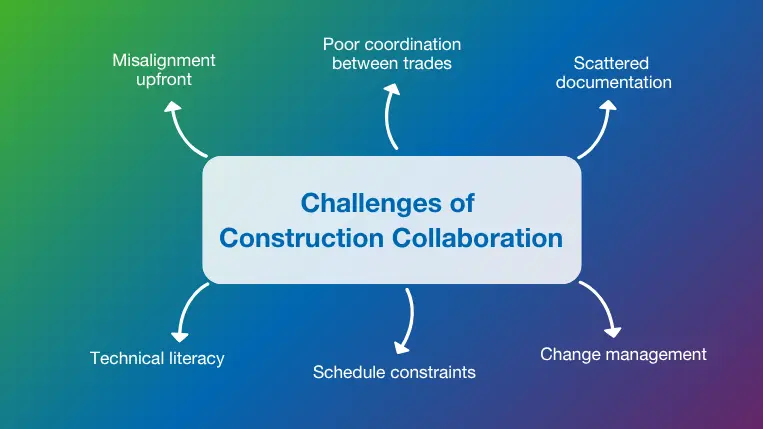
Collaboration in construction is very important, but it can also be challenging to implement. Construction is a complex business, creating many obstacles and distractions that sometimes prevent us from working together as well as we should. Let’s explore some common challenges below.
Misalignment Upfront
As American baseball legend, Yogi Berra, once said, “If you don’t know where you are going, you might wind up someplace else.” Collaboration at the beginning of a project can facilitate alignment between designers, architects, and construction crews that lasts throughout the whole lifecycle.
On the other hand, a misalignment that begins earlier can grow progressively worse. The key is for all major players to be on the same page before each phase of the project kicks off, and that requires collaboration.
Poor Coordination Between Trades
Each trade has its own timelines and objectives, which don’t always mesh perfectly with other trades. Proper planning and project management in construction can improve coordination between trades, but this requires effective collaboration among all parties involved.
For example, electrical work might need to be completed before walls are closed, but if plumbing work is delayed, it could disrupt the electrical installation process. A lack of coordination and teamwork in construction projects can cause delays, rework, frustration, and increased costs. Conversely, open communication and collaboration among trades can overcome these challenges and improve efficiency.
Scattered Documentation
By their very nature, construction projects can be spread out and complicated, with everything from materials and supplies to plans and written documents scattered. If different teams or stakeholders work on different versions of the same plans or documents, this can create schedule and safety risks.
Moving from paper documents and blueprints to electronic files has gone a long way toward breaking down these collaboration obstacles in recent years, but there’s still more work to be done. Teams and subcontractors on the same project might use incompatible file-sharing systems or software platforms. Planning and communication are key to getting ahead of these potential pitfalls.
Change Management
Construction projects, especially larger ones, continually change their timelines, budgets, and designs. The pace of change requires all trades and stakeholders to be on the same page and understand the impact of changes on their tasks. Change can only be managed effectively when clear communication and collaboration channels exist.
In addition, resistance to change from stakeholders accustomed to traditional practices or hesitant to adopt new ideas can also complicate construction change management. Dealing with change through collaboration requires strong leadership and a commitment to collaboration tools that benefit all project participants.
Schedule Constraints
Schedule compression is becoming more common in construction, with contractors attempting to meet aggressive deadlines without increasing the project scope. This usually involves overtime, fast-tracking of activities, and increased pressure that reduces the time available to coordinate and exchange critical information. When the time for collaboration is sacrificed, increased errors, safety issues, and decreased morale can be the result.
Technical Literacy
While some construction professionals have fully embraced digital collaboration tools and have learned how to incorporate the most useful features into their everyday tasks, others are more resistant to technology and prefer to stick with traditional communication methods. This can lead to problems when stakeholders rely on different methods to collaborate, or disagree over the best ways to share information and ideas.
Construction companies are addressing the digital literacy issue by providing training programs for new employees, upskilling, or hiring workers who are already comfortable with technology and software. This support from employers helps to change the culture so that everyone looks forward to learning about the latest technology and using it to improve results.
How Technology Improves Construction Collaboration
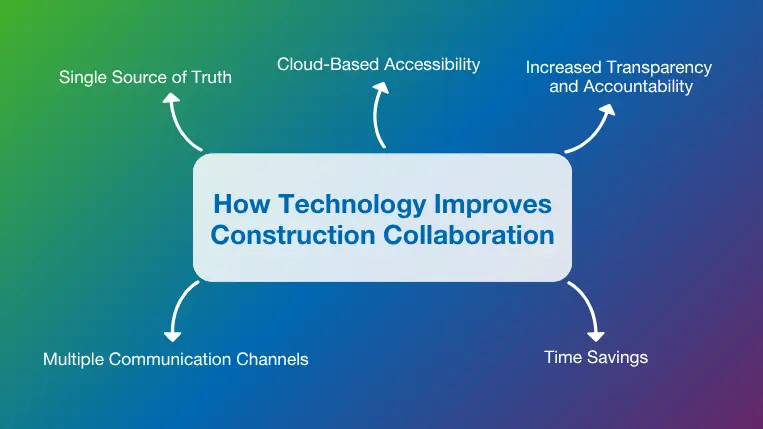
Technology is sometimes thought of as counterproductive to collaboration, since computer screens and devices taking the place of in-person meetings and discussions can make problem-solving and team-building processes seem less personal and interactive. At the same time, project teams dispersed around the world, or working on expansive job sites, find advantages in construction collaboration technology as they use these tools to communicate more efficiently and more often.
Single Source of Truth
Decades ago, contractors and subcontractors were likely to find themselves working from outdated construction specifications or blueprints, based on the logistical challenges of delivering the latest information from the office to the field. Computer technology and construction management software have eliminated this dilemma by providing easy access to a consolidated repository of all project drawings, contracts, changes, and other information. This single source of truth ensures everyone is completing their tasks based on the most up-to-date information, and can upload annotations, construction punch lists, and other records to the database to keep other stakeholders informed.
Cloud-Based Accessibility
Cloud computing is not a new concept, with customers enjoying the convenience of software applications, data storage, and computing resources on remote servers for over two decades. In recent years, leveraging cloud-based accessibility for specialized construction software tools has been recognized as one of the keys to improved collaboration in construction.
The cloud, together with mobile-friendly software and apps, enables a secure, centralized ‘single source of truth’ which is accessible to project teams anytime, anywhere, without the typical limitations on user access or data volume. This gives all stakeholders access to real-time access to project information, and an easier way to exchange information quickly and securely over a common channel.
Increased Transparency and Accountability
Transparency and accountability are two of the most important benefits of collaboration in construction, and technology dramatically improves these attributes. Digital construction technologies like drones and IoT sensors, make it possible to gather information on project status, bottlenecks, and errors with less physical trips to the site. This visibility eliminates the guesswork and reliance of daily reporting that once slowed communication between teams.
These tools also make each contractor and subcontractor more accountable by simplifying progress tracking and expense reporting processes so that any cost, quality, or productivity issues can be resolved without delay. Accountability among teams and individuals increases the odds of success by improving trust, morale, and schedule adherence.
Time Savings
Collaboration in construction projects saves time in many ways, since clear communication helps to streamline workflows, accelerate problem-solving, and reduce rework, among many other efficiency benefits. Strong collaboration using cloud-based software ensures everyone is working together, making it unnecessary to spend time correcting errors and misunderstandings before or after tasks are completed.
When teams collaborate on schedules and workflows, these tasks can be planned in an order that optimizes productivity and reduces downtime. Effective collaboration also speeds up decision-making processes and prevents bottlenecks when the knowledge of the entire team is leveraged on a digital platform.
Multiple Communication Channels
Face-to-face communication was once the only option for construction project collaboration, which presented challenges when key stakeholders were in different locations or working on multiple projects simultaneously. Technology has now multiplied the number of available communication channels many times over, with mobile apps, wearable technology, cloud-based software tools, and wireless communication methods ensuring distance and mobility no longer stand in the way of information sharing. Software and technology also make it possible to generate real-time reports quickly and automate many of the tasks that enhance collaboration.
Construction Collaboration Technologies
Technology takes on many different forms in the construction industry, and innovations designed to improve productivity, safety, and organization also provide convenient and flexible avenues of communication. The benefits of collaboration in construction continue to grow, along with a list of available technologies.
BIM
Building information modeling (BIM) is redefining construction projects by providing a centralized digital platform for design teams to create and test multi-dimensional models of buildings and other structures. BIM accelerates design processes and helps to eliminate errors, clashes, and safety issues, and also improves collaboration among team members by creating a repository for project information that can be accessed from anywhere.
Using the BIM model, different design teams can work on the project at the same time, and share their important findings and observations along the way. For example, structural engineers can work on optimizing the strength and resilience of the building while sustainability engineers search for ways to make the structure more energy efficient.
Document Management Software
There are many solutions available to improve collaboration, including procurement, estimating, and project management software that brings stakeholders together to streamline the most essential processes. Construction document management software has improved collaboration significantly by automating version control and allowing information to be exchanged between site and office teams efficiently.
When all documents, drawings, plans, and other files are stored in the same location, it makes it easier for everyone to find what they need quickly, and review the latest information together online so that any documentation issues are resolved before they lead to costly errors or rework.
Mobile Tools
The addition of mobility to the digital toolkit was a real breakthrough for construction project collaboration, with cell phones, tablets, and other devices finally making it possible to carry valuable construction documents and data into the field without worrying about obsolescence. Features like instant messaging, alerts, and digital markups speed up the transfer of information from the field so that building and safety issues are communicated to the appropriate team members.
This focus on mobility is now being taken to the next level, with advanced technologies like construction drones and augmented reality (AR) allowing construction workers to expand their reach and communicate real-time information in many useful and exciting ways.
Tips to Improve Construction Collaboration
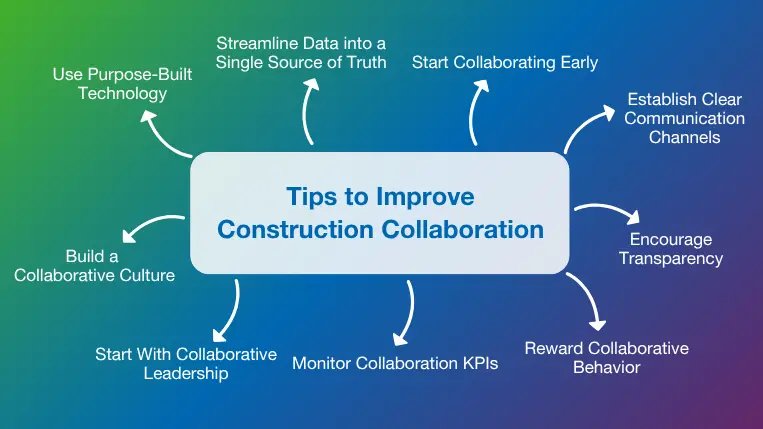
Now that we have established that construction project managers should prioritize strong collaboration, here are the best ways to achieve this.
1) Use Purpose-Built Technology
Working with cloud-based construction software ensures everyone can access up-to-date information from anywhere, whenever needed.
You can make faster decisions by sharing real-time project data and insights across different teams. Moreover, you will have easy access to project data and will always be up to date with the project’s status.
Access to comprehensive, real-time data is essential for strong collaboration. Improved construction collaboration technology allows everyone to track project progress at every stage and work together to complete it effectively.
2) Streamline Data into a Single Source of Truth
Having only one platform where project data is stored allows everyone to access that data and collaborate on it more easily. If you rely on disjointed spreadsheets, tools, and email threads, collaboration can get messy quickly. Not everyone will access the same information, resulting in confusion, duplicate work, and project delays. A unified platform is essential for keeping everyone on the same page.
3) Start Collaborating Early
Introduce key collaboration construction concepts right from the project’s planning phase. By bringing together all the key players early on, the project stands a better chance of delivering a solid design, a stronger plan of action, and improved decision-making throughout all stages. This will help the project move more smoothly and ultimately be more successful. An early focus on collaboration will also foster teamwork, communication, and trust that continues to improve as the project progresses.
4) Establish Clear Communication Channels
Most of the project rework in construction is caused by miscommunication and poor project data. Some of this miscommunication can be due to busy schedules or a lack of regular meetings, but the benefits of making time for structured communication far outweigh the downside.
Communication channels include everything from cloud-based software and email messages to verbal communication and hand-written notes. The key lies in setting up ground rules and regular intervals for communication and sticking to them.
5) Encourage Transparency
For stakeholders to collaborate, they must understand what others are doing well. The word ‘transparency’ is sometimes overused, but collaboration in construction gives this idea new meaning and importance. Transparency on a job site is based on sharing information openly without worrying about judgment or criticism.
Transparent practices help avoid misunderstandings, conflicts, and delays by promoting open communication and visibility of project activities. They also encourage accountability and promote a culture of teamwork, where everyone feels more empowered to freely share their opinions and concerns.
6) Reward Collaborative Behavior
One of the best ways to encourage positive behavior is to reward it more often. Workers usually respond well to cash incentives, but rewards and recognition don’t always need to be in the form of money.
Simply complimenting someone when they share their opinions in a meeting or work with others to form a solution can go a long way. Showing appreciation and gratitude for collaboration within the construction team can enhance morale and highlight the importance of collaborative behaviors and their results.
7) Monitor Collaboration KPIs
Key performance indicators (KPIs) assign values to things most important to a person or business. KPIs can be a valuable tool for improving construction project collaboration.
Measurable outcomes like schedule adherence, rework rates, the number of tasks completed on time, and the time taken to complete key tasks are examples of metrics that can be monitored in your construction reports to encourage teamwork. The real value of KPIs lies in following them over time to track their improvement.
8) Start With Collaborative Leadership
Why is leadership so important for collaborative working in construction? As the saying goes, “It all starts at the top.” Individual workers and teams can focus on improving collaboration for themselves, but any real changes will need to be supported by collaborative construction management.
Project managers, finance managers, and general contractors set the tone for collaboration by practicing open communication and encouraging others to do the same. They also provide tools, such as cloud-based construction software, which remove barriers to cooperation and purposefully break down silos to give everyone access to the same information.
9) Build a Collaborative Culture
Leadership also plays an important role in building a culture of collaboration. Culture comprises behavior changes and norms that become habits instead of one-time events or ideas that never take root. One way to build a better culture of collaboration is by offering workers training in subjects like conflict resolution, problem-solving, and team building that they can apply to their daily work. Another way to improve the culture is by sharing a high-level vision. Brief, clear memos can highlight collaboration’s importance to all stakeholders.
Start Improving Your Construction Team Collaboration
As you learned throughout this post, collaboration benefits everyone in construction. Different teams must work effectively together if they want projects to move along more efficiently and achieve better results.
The best way to do this is to use innovative construction collaboration software, such as RIB Connex, RIB CX or RIB Project. These solutions are intentionally designed to improve collaboration and communication. With the right tools, any project can operate more smoothly and get the best return on investment possible.
If you are ready to boost collaboration in your construction projects, get a free demo of RIB Software and experience the power of enhanced accessibility!
Most Recent
11 mins read
10 mins read
10 mins read
29 mins read
Blog Categories

Ebook
